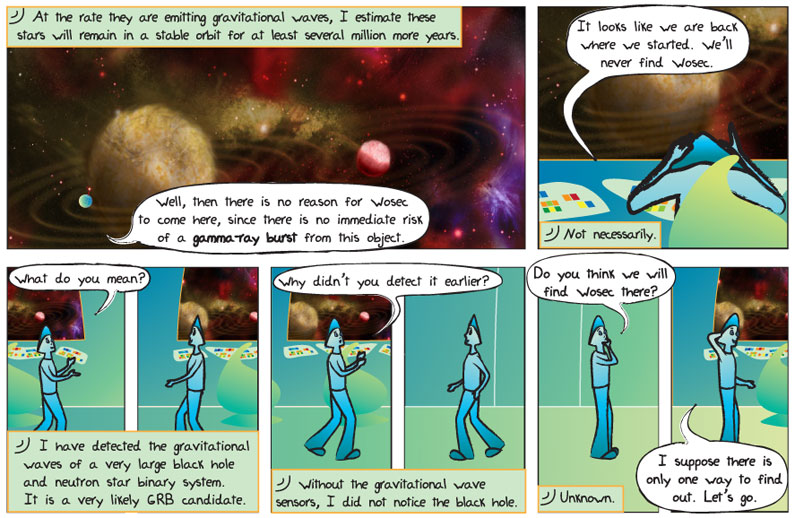
Comic Transcript
Panel 1.
Epo: At the rate they are emitting gravitational waves, I estimate these stars will remain in a stable orbit for at least several million more years.
Panel 2.
Alkina: Well, then there is no reason for Wosec to come here, since there is no risk of a gamma-ray burst from this object.
Panel 3.
Alkina: It looks like we are back where we started. We’ll never find Wosec.
Epo: Not necessarily.
Panel 4.
Alkina: What do you mean?
Epo: I have detected the gravitational waves of a very large black hole and neutron star binary system. It is a very strong GRB candidate.
Panel 5.
Alkina: Why didn’t you detect it earlier?
Epo: Without the gravitational wave sensors, I was not able to detect the black hole.
Panel 6.
Alkina: Do you think we will find Wosec there?
Epo: Unknown.
Alkina: I suppose there is only one way to find out. Let’s go.
What does it mean?
Gamma-ray burst – a brief, but very energetic burst of the most powerful form of electromagnetic radiation.
In human speak please!
We’ve already discussed how gamma-ray bursts could be created in extremely large and powerful supernova explosions called hypernovae. Another possible progenitor of GRB’s is a collision between neutron stars. When two neutron stars orbit around their mutual center of gravity, they radiate gravitational waves, which causes them to slowly bleed away energy. As they lose energy, they fall in towards one another. Eventually they will collide. Neutron stars are very massive but very small, meaning they are extremely dense; a teaspoon of neutron star material would weigh over 5 billion tons. If you were to somehow stand on the surface of one, the gravity would be around 1011 times stronger than the gravity is on Earth. When two objects like these collide, the forces in play are immense, and the amount of energy released is enough to generate the most energetic event in the known Universe: a gamma-ray burst.
Is that all?
Inspiral gravitational wave – explains what the gravitational wave signal from two massive objects spiraling towards each other should look like (and sound like, if you could hear it).
Binary Neutron Star Collision – Hayden Planetarium page about Neutron star collisions (with video).
